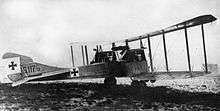Rumpler G.I
| G.I, G.II and G.III | |
|---|---|
.jpg) | |
| Rumpler G.III | |
| Role | Bomber aircraft |
| National origin | Germany |
| Manufacturer | Rumpler |
| First flight | 1915 |
| Primary user | Luftstreitkräfte |
| Number built | ca. 222 |
|
| |

The Rumpler G.I was a bomber aircraft produced in Germany during World War I, together with refined versions known as the G.II and G.III.[1]
Design and development
Based on a prototype with the factory designation 4A15, the G.I and its successors were built to a conventional bomber design for their time, two-bay biplanes with unstaggered wings of unequal span.[2] The pilot sat in an open cockpit just forward of the wings, and open positions were provided in the nose and amidships for a gunner and observer. The engines were mounted pusher-fashion in nacelles atop the lower wings and enclosed in streamlined cowlings.[2] Fixed tricycle undercarriage was fitted, with dual wheels on each unit.[2]
The G.II version was almost identical, but featured more powerful engines and carried a second 7.92 mm (.312 in) machine gun and increased bombload.[2] The G.III was again similar, but had engine nacelles that were now mounted on short struts clear of the lower wing.[2]
Variants

- 4A15 - prototype with Benz Bz.III engines[3]
- 5A15 - G.I production version with single machine gun and Benz Bz.III or Mercedes D.III engines[4] (ca 60 built)[2]
- 5A16 - G.II production version with Benz Bz.IV engines and two machine guns[5] (ca. 72 built)[6]
- 6G2 - G.III production version with Mercedes D.IV engines and two machine guns[7] (ca. 90 built)[6]
Specifications (G.III)

Data from Kroschel & Stützer 1994, p.140
General characteristics
- Crew: Three
- Length: 12.00 m (39 ft 4 in)
- Wingspan: 19.30 m (63 ft 4 in)
- Height: 4.50 m (19 ft 2 in)
- Wing area: 73.0 m2 (785 ft2)
- Empty weight: 2,365 kg (5,203 lb)
- Gross weight: 3,620 kg (7,964 lb)
- Powerplant: 2 × Mercedes D.IV, 190 kW (260 hp) each
Performance
- Maximum speed: 165 km/h (103 mph)
- Range: 700 km (440 miles)
- Service ceiling: 5,000 m (16,000 ft)
Armament
- 1 × trainable 7.92 mm (.312 in) Parabellum MG14 machine gun in nose
- 1 × trainable 7.92 mm (.312 in) Parabellum MG14 machine gun in dorsal position
- 250 kg (550 lb) of bombs
Notes
References
| Wikimedia Commons has media related to |
- Gray, Peter; Owen Thetford (1962). German Aircraft of the First World War. London: Putnam.
- The Illustrated Encyclopedia of Aircraft. London: Aerospace Publishing.
- Kroschel, Günter; Helmut Stützer (1994). Die Deutschen Militärflugzeuge 1910–1918. Herford: Verlag E.S. Mittler & Sohn.
- Taylor, Michael J. H. (1989). Jane's Encyclopedia of Aviation. London: Studio Editions.